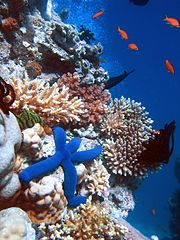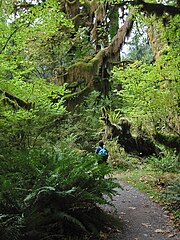Ecosystem
| Part of a series on |
| Biology |
|---|
An ecosystem (or ecological system) is a system that
Ecosystems are controlled by external and internal factors. External factors such as climate, parent material which forms the soil and topography, control the overall structure of an ecosystem but are not themselves influenced by the ecosystem. Internal factors are controlled, for example, by decomposition, root competition, shading, disturbance, succession, and the types of species present. While the resource inputs are generally controlled by external processes, the availability of these resources within the ecosystem is controlled by internal factors. Therefore, internal factors not only control ecosystem processes but are also controlled by them.
Ecosystems are
Plants allow energy to enter the system through
Ecosystems provide a variety of goods and services upon which people depend, and may be part of. Ecosystem goods include the "tangible, material products" of ecosystem processes such as water, food, fuel, construction material, and
Definition
An ecosystem (or ecological system) consists of all the organisms and the abiotic pools (or physical environment) with which they interact.[3][4]: 5 [2]: 458 The biotic and abiotic components are linked together through nutrient cycles and energy flows.[5]
"Ecosystem processes" are the transfers of energy and materials from one pool to another.[2]: 458 Ecosystem processes are known to "take place at a wide range of scales". Therefore, the correct scale of study depends on the question asked.[4]: 5
Origin and development of the term
The term "ecosystem" was first used in 1935 in a publication by British ecologist Arthur Tansley. The term was coined by Arthur Roy Clapham, who came up with the word at Tansley's request.[6] Tansley devised the concept to draw attention to the importance of transfers of materials between organisms and their environment.[4]: 9 He later refined the term, describing it as "The whole system, ... including not only the organism-complex, but also the whole complex of physical factors forming what we call the environment".[3] Tansley regarded ecosystems not simply as natural units, but as "mental isolates".[3] Tansley later defined the spatial extent of ecosystems using the term "ecotope".[7]
Processes


External and internal factors
Ecosystems are controlled by both external and internal factors. External factors, also called state factors, control the overall structure of an ecosystem and the way things work within it, but are not themselves influenced by the ecosystem. On broad geographic scales, climate is the factor that "most strongly determines ecosystem processes and structure".[4]: 14 Climate determines the biome in which the ecosystem is embedded. Rainfall patterns and seasonal temperatures influence photosynthesis and thereby determine the amount of energy available to the ecosystem.[8]: 145
Parent material determines the nature of the soil in an ecosystem, and influences the supply of mineral nutrients. Topography also controls ecosystem processes by affecting things like microclimate, soil development and the movement of water through a system. For example, ecosystems can be quite different if situated in a small depression on the landscape, versus one present on an adjacent steep hillside.[9]: 39 [10]: 66
Other external factors that play an important role in ecosystem functioning include time and potential
Unlike external factors, internal factors in ecosystems not only control ecosystem processes but are also controlled by them.[4]: 16 While the resource inputs are generally controlled by external processes like climate and parent material, the availability of these resources within the ecosystem is controlled by internal factors like decomposition, root competition or shading.[13] Other factors like disturbance, succession or the types of species present are also internal factors.
Primary production
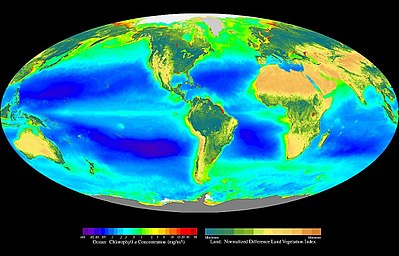
Primary production is the production of organic matter from inorganic carbon sources. This mainly occurs through photosynthesis. The energy incorporated through this process supports life on earth, while the carbon makes up much of the organic matter in living and dead biomass, soil carbon and fossil fuels. It also drives the carbon cycle, which influences global climate via the greenhouse effect.
Through the process of photosynthesis, plants capture energy from light and use it to combine
Energy flow
Energy and carbon enter ecosystems through photosynthesis, are incorporated into living tissue, transferred to other organisms that feed on the living and dead plant matter, and eventually released through respiration.[14]: 157 The carbon and energy incorporated into plant tissues (net primary production) is either consumed by animals while the plant is alive, or it remains uneaten when the plant tissue dies and becomes detritus. In terrestrial ecosystems, the vast majority of the net primary production ends up being broken down by decomposers. The remainder is consumed by animals while still alive and enters the plant-based trophic system. After plants and animals die, the organic matter contained in them enters the detritus-based trophic system.[15]
Ecosystem respiration is the sum of respiration by all living organisms (plants, animals, and decomposers) in the ecosystem.[16] Net ecosystem production is the difference between gross primary production (GPP) and ecosystem respiration.[17] In the absence of disturbance, net ecosystem production is equivalent to the net carbon accumulation in the ecosystem.
Energy can also be released from an ecosystem through disturbances such as wildfire or transferred to other ecosystems (e.g., from a forest to a stream to a lake) by erosion.
In
The sequence of consumption—from plant to herbivore, to carnivore—forms a food chain. Real systems are much more complex than this—organisms will generally feed on more than one form of food, and may feed at more than one trophic level. Carnivores may capture some prey that is part of a plant-based trophic system and others that are part of a detritus-based trophic system (a bird that feeds both on herbivorous grasshoppers and earthworms, which consume detritus). Real systems, with all these complexities, form food webs rather than food chains.[15]
Decomposition

The carbon and nutrients in dead organic matter are broken down by a group of processes known as decomposition. This releases nutrients that can then be re-used for plant and microbial production and returns carbon dioxide to the atmosphere (or water) where it can be used for photosynthesis. In the absence of decomposition, the dead organic matter would accumulate in an ecosystem, and nutrients and atmospheric carbon dioxide would be depleted.[18]: 183
Decomposition processes can be separated into three categories—leaching, fragmentation and chemical alteration of dead material. As water moves through dead organic matter, it dissolves and carries with it the water-soluble components. These are then taken up by organisms in the soil, react with mineral soil, or are transported beyond the confines of the ecosystem (and are considered lost to it).[19]: 271–280 Newly shed leaves and newly dead animals have high concentrations of water-soluble components and include sugars, amino acids and mineral nutrients. Leaching is more important in wet environments and less important in dry ones.[10]: 69–77
Fragmentation processes break organic material into smaller pieces, exposing new surfaces for colonization by microbes. Freshly shed
The chemical alteration of the dead organic matter is primarily achieved through bacterial and fungal action. Fungal hyphae produce enzymes that can break through the tough outer structures surrounding dead plant material. They also produce enzymes that break down lignin, which allows them access to both cell contents and the nitrogen in the lignin. Fungi can transfer carbon and nitrogen through their hyphal networks and thus, unlike bacteria, are not dependent solely on locally available resources.[18]: 186
Decomposition rates
Decomposition rates vary among ecosystems.[20] The rate of decomposition is governed by three sets of factors—the physical environment (temperature, moisture, and soil properties), the quantity and quality of the dead material available to decomposers, and the nature of the microbial community itself.[18]: 194 Temperature controls the rate of microbial respiration; the higher the temperature, the faster the microbial decomposition occurs. Temperature also affects soil moisture, which affects decomposition. Freeze-thaw cycles also affect decomposition—freezing temperatures kill soil microorganisms, which allows leaching to play a more important role in moving nutrients around. This can be especially important as the soil thaws in the spring, creating a pulse of nutrients that become available.[19]: 280
Decomposition rates are low under very wet or very dry conditions. Decomposition rates are highest in wet, moist conditions with adequate levels of oxygen. Wet soils tend to become deficient in oxygen (this is especially true in wetlands), which slows microbial growth. In dry soils, decomposition slows as well, but bacteria continue to grow (albeit at a slower rate) even after soils become too dry to support plant growth.[18]: 200
Dynamics and resilience
Ecosystems are dynamic entities. They are subject to periodic disturbances and are always in the process of recovering from past disturbances.
Disturbance also plays an important role in ecological processes. F. Stuart Chapin and coauthors define disturbance as "a relatively discrete event in time that removes plant biomass".[21]: 346 This can range from herbivore outbreaks, treefalls, fires, hurricanes, floods, glacial advances, to volcanic eruptions. Such disturbances can cause large changes in plant, animal and microbe populations, as well as soil organic matter content. Disturbance is followed by succession, a "directional change in ecosystem structure and functioning resulting from biotically driven changes in resource supply."[2]: 470
The frequency and severity of disturbance determine the way it affects ecosystem function. A major disturbance like a volcanic eruption or glacial advance and retreat leave behind soils that lack plants, animals or organic matter. Ecosystems that experience such disturbances undergo primary succession. A less severe disturbance like forest fires, hurricanes or cultivation result in secondary succession and a faster recovery.[21]: 348 More severe and more frequent disturbance result in longer recovery times.
From one year to another, ecosystems experience variation in their biotic and abiotic environments. A drought, a colder than usual winter, and a pest outbreak all are short-term variability in environmental conditions. Animal populations vary from year to year, building up during resource-rich periods and crashing as they overshoot their food supply. Longer-term changes also shape ecosystem processes. For example, the forests of eastern North America still show legacies of cultivation which ceased in 1850 when large areas were reverted to forests.[21]: 340 Another example is the methane production in eastern Siberian lakes that is controlled by organic matter which accumulated during the Pleistocene.[25]
Nutrient cycling

Ecosystems continually exchange energy and carbon with the wider
Macronutrients which are required by all plants in large quantities include the primary nutrients (which are most limiting as they are used in largest amounts): Nitrogen, phosphorus, potassium.[27]: 231 Secondary major nutrients (less often limiting) include: Calcium, magnesium, sulfur. Micronutrients required by all plants in small quantities include boron, chloride, copper, iron, manganese, molybdenum, zinc. Finally, there are also beneficial nutrients which may be required by certain plants or by plants under specific environmental conditions: aluminum, cobalt, iodine, nickel, selenium, silicon, sodium, vanadium.[27]: 231
Until modern times, nitrogen fixation was the major source of nitrogen for ecosystems. Nitrogen-fixing bacteria either live
When plant tissues are shed or are eaten, the nitrogen in those tissues becomes available to animals and microbes. Microbial decomposition releases nitrogen compounds from dead organic matter in the soil, where plants, fungi, and bacteria compete for it. Some soil bacteria use organic nitrogen-containing compounds as a source of carbon, and release
Mycorrhizal fungi which are symbiotic with plant roots, use carbohydrates supplied by the plants and in return transfer phosphorus and nitrogen compounds back to the plant roots.[28][29] This is an important pathway of organic nitrogen transfer from dead organic matter to plants. This mechanism may contribute to more than 70 Tg of annually assimilated plant nitrogen, thereby playing a critical role in global nutrient cycling and ecosystem function.[29]
Phosphorus enters ecosystems through weathering. As ecosystems age this supply diminishes, making phosphorus-limitation more common in older landscapes (especially in the tropics).[19]: 287–290 Calcium and sulfur are also produced by weathering, but acid deposition is an important source of sulfur in many ecosystems. Although magnesium and manganese are produced by weathering, exchanges between soil organic matter and living cells account for a significant portion of ecosystem fluxes. Potassium is primarily cycled between living cells and soil organic matter.[19]: 291
Function and biodiversity
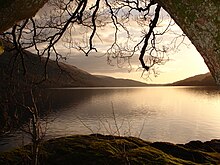
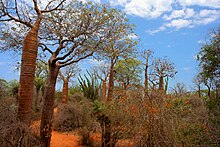
The addition (or loss) of species that are ecologically similar to those already present in an ecosystem tends to only have a small effect on ecosystem function. Ecologically distinct species, on the other hand, have a much larger effect. Similarly, dominant species have a large effect on ecosystem function, while rare species tend to have a small effect. Keystone species tend to have an effect on ecosystem function that is disproportionate to their abundance in an ecosystem.[11]: 324
An
Study approaches
Ecosystem ecology
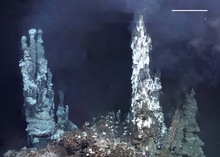
Ecosystem ecology is the "study of the interactions between organisms and their environment as an integrated system".[2]: 458 The size of ecosystems can range up to ten orders of magnitude, from the surface layers of rocks to the surface of the planet.[4]: 6
The
Ecosystems can be studied through a variety of approaches—theoretical studies, studies monitoring specific ecosystems over long periods of time, those that look at differences between ecosystems to elucidate how they work and direct manipulative experimentation.
Classifications
Biomes are general classes or categories of ecosystems.[4]: 14 However, there is no clear distinction between biomes and ecosystems.[39] Biomes are always defined at a very general level. Ecosystems can be described at levels that range from very general (in which case the names are sometimes the same as those of biomes) to very specific, such as "wet coastal needle-leafed forests".
Biomes vary due to global variations in climate. Biomes are often defined by their structure: at a general level, for example, tropical forests, temperate grasslands, and arctic tundra.[4]: 14 There can be any degree of subcategories among ecosystem types that comprise a biome, e.g., needle-leafed boreal forests or wet tropical forests. Although ecosystems are most commonly categorized by their structure and geography, there are also other ways to categorize and classify ecosystems such as by their level of human impact (see anthropogenic biome), or by their integration with social processes or technological processes or their novelty (e.g. novel ecosystem). Each of these taxonomies of ecosystems tends to emphasize different structural or functional properties.[40] None of these is the "best" classification.
Human interactions with ecosystems
Human activities are important in almost all ecosystems. Although humans exist and operate within ecosystems, their cumulative effects are large enough to influence external factors like climate.[4]: 14
Ecosystem goods and services

Ecosystems provide a variety of goods and services upon which people depend.
The
The Intergovernmental Science-Policy Platform on Biodiversity and Ecosystem Services (IPBES) is an intergovernmental organization established to improve the interface between science and policy on issues of biodiversity and ecosystem services.[46][47] It is intended to serve a similar role to the Intergovernmental Panel on Climate Change.[48]
Ecosystem services are limited and also threatened by human activities.[49] To help inform decision-makers, many ecosystem services are being assigned economic values, often based on the cost of replacement with anthropogenic alternatives. The ongoing challenge of prescribing economic value to nature, for example through biodiversity banking, is prompting transdisciplinary shifts in how we recognize and manage the environment, social responsibility, business opportunities, and our future as a species.[49]
Degradation and decline
As human population and per capita consumption grow, so do the resource demands imposed on ecosystems and the effects of the human
Many ecosystems become degraded through human impacts, such as soil loss, air and water pollution, habitat fragmentation, water diversion, fire suppression, and introduced species and invasive species.[51]: 437
These threats can lead to abrupt transformation of the ecosystem or to gradual disruption of biotic processes and degradation of
Management
When natural resource management is applied to whole ecosystems, rather than single species, it is termed ecosystem management.[54] Although definitions of ecosystem management abound, there is a common set of principles which underlie these definitions: A fundamental principle is the long-term sustainability of the production of goods and services by the ecosystem;[51] "intergenerational sustainability [is] a precondition for management, not an afterthought".[42] While ecosystem management can be used as part of a plan for wilderness conservation, it can also be used in intensively managed ecosystems[42] (see, for example, agroecosystem and close to nature forestry).
Restoration and sustainable development
Integrated conservation and development projects (ICDPs) aim to address conservation and human livelihood (sustainable development) concerns in developing countries together, rather than separately as was often done in the past.[51]: 445
See also
Types
The following articles are types of ecosystems for particular types of regions or zones:
- Aquatic ecosystem
- Freshwater ecosystem
- Lake ecosystem (lentic ecosystem)
- River ecosystem (lotic ecosystem)
- Marine ecosystem
- Large marine ecosystem
- Tropical salt pond ecosystem
- Freshwater ecosystem
- Terrestrial ecosystem
- Boreal ecosystem
- Groundwater-dependent ecosystems
- Montane ecosystem
- Urban ecosystem
- Ecosystems grouped by condition
- Agroecosystem
- Closed ecosystem
- Depauperate ecosystem
- Novel ecosystem
- Reference ecosystem
Instances
Ecosystem instances in specific regions of the world:
- Greater Yellowstone Ecosystem
- Leuser Ecosystem
- Longleaf pine Ecosystem
- Tarangire Ecosystem
References
- PMID 21232343.
- ^ OCLC 755081405.
- ^ JSTOR 1930070. Archived from the original(PDF) on 2016-10-06.
- ^ OCLC 755081405.
- ISBN 978-0-534-42066-6.
- .
- ^ Tansley, A.G. (1939). The British Islands and Their Vegetation. Cambridge University Press.
- ^ OCLC 755081405.
- OCLC 755081405.
- ^ OCLC 755081405.
- ^ OCLC 755081405.
- PMID 22889499.
- ^ "46.1A: Ecosystem Dynamics". Biology LibreTexts. 2018-07-17. Archived from the original on 2021-08-02. Retrieved 2021-08-02.

 Text was copied from this source, which is available under a Creative Commons Attribution 4.0 International License Archived 2017-10-16 at the Wayback Machine.
Text was copied from this source, which is available under a Creative Commons Attribution 4.0 International License Archived 2017-10-16 at the Wayback Machine.
- ^ OCLC 755081405.
- ^ OCLC 755081405.
- S2CID 4422427.
- S2CID 5890190.
- ^ OCLC 755081405.
- ^ OCLC 755081405.
- S2CID 92606851.
- ^ OCLC 755081405.
- OCLC 432702920.
- from the original on 2019-05-17. Retrieved 2021-07-23.
- ^ Simonsen, S.H. "Applying Resilience Thinking" (PDF). Stockholm Resilience Centre. Archived (PDF) from the original on 2017-12-15.
- S2CID 4415304. Archived from the original(PDF) on Nov 23, 2011. Retrieved 2021-08-16.
- PMID 20349827.
- ^ OCLC 755081405.
- S2CID 44215263.
- ^ PMID 31263777.
- S2CID 6894397.
- ISBN 978-3-540-20833-4.
- ISBN 978-0-691-12839-9.
- JSTOR 3545850.
- ISBN 978-1-84971-145-6.
- JSTOR 3450233. Archived from the original(PDF) on 2013-05-01.
- S2CID 33559404.
- S2CID 45418039.
- JSTOR 2265490.
- ^ "Differences Between the Grassland & the Tundra". Sciencing. Archived from the original on 2021-07-16. Retrieved 2021-07-16.
- ^ S2CID 241360441.
- PMID 36224387.
- ^ S2CID 53461068.
- ^ "Ecosystem Goods and Services" (PDF). Archived (PDF) from the original on 2009-11-10.
- ^ a b c Brown, Thomas C.; John C. Bergstrom; John B. Loomis (2007). "Defining, valuing and providing ecosystem goods and services" (PDF). Natural Resources Journal. 47 (2): 329–376. Archived from the original (PDF) on 2013-05-25.
- ^ a b "Millennium Ecosystem Assessment". 2005. Archived from the original on 2011-05-24. Retrieved 10 November 2021.
- ^ "IPBES". Archived from the original on 27 June 2019. Retrieved 28 June 2019.
- S2CID 14000233.
- ^ "Biodiversity crisis is worse than climate change, experts say". ScienceDaily. January 20, 2012. Archived from the original on December 29, 2021. Retrieved September 11, 2019.
- ^ S2CID 46200068.
- ISBN 978-0-412-74050-3.
- ^ OCLC 755081405.
- PMID 23667454.
- doi:10.1046/j.1523-1739.1994.08010027.x. Archived from the original(PDF) on 2013-05-02.
External links
 Media related to Ecosystems at Wikimedia Commons
Media related to Ecosystems at Wikimedia Commons The dictionary definition of ecosystem at Wiktionary
The dictionary definition of ecosystem at Wiktionary- Wikidata: topic (Scholia)
 Biomes and ecosystems travel guide from Wikivoyage
Biomes and ecosystems travel guide from Wikivoyage

